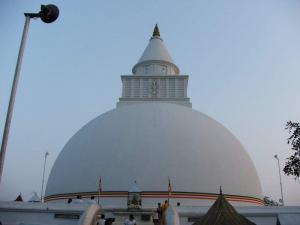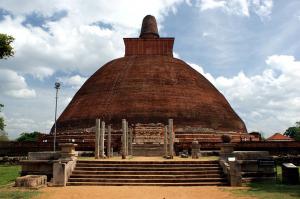Mahasena, also known in some records as Mahasen, was a king of Sri Lanka who ruled the country from 277 to 304 AD. He started the construction of large tanks or reservoirs in Sri Lanka,[1] and built sixteen such tanks.[2] After becoming king, Mahasen discriminated against Theravada Buddhists in the country, and destroyed several temples including Mahavihara, the main Theravada temple, before his chief minister led him to realise his mistakes.[3] The Jethavana stupa was also built by Mahasen. His countrymen regarded him as a god or deity after the construction of the Minneriya tank, and he was named Minneri Deviyo (God of Minneriya).
Mahasen was the younger son of King Gotabaya, who ruled the country from 253 to 266. His elder brother and predecessor to the throne was King Jetthatissa, who was the king from 266 to 275. Mahasen and Jetthatissa were educated by a Buddhist monk named Sanghamitta, who was a follower of the Vaitulya doctrine. Mahasen also became a follower of this doctrine, which was associated with Mahayana Buddhism. Theravada Buddhism was traditionally the official religion of the country. However when Mahasen acquired the throne, he ordered the Bhikkhus of Mahavihara, the largest Theravada temple in the country, to accept Mahayana teachings. When they refused, Mahasen prohibited his countrymen from providing food to the Theravada Bhikkhus, and established a fine for violating this. As a result, the Buddhist monks abandoned Anuradhapura and went to the Ruhuna municipality in the South of the country.
Mahasen destroyed the Mahavihara, and the materials obtained from there were used for building the Jethavanaramaya. Lovamahapaya, which belonged to the Mahavihara, was also destroyed. After this incident, the king’s chief minister and friend, Meghavannabaya, rebelled and raised an army in Ruhuna against him. The king came with his army to defeat Meghavannabaya and camped opposite the rebel camp. On the night before the battle was to be fought, Meghavannabaya managed to enter Mahasen’s camp and convinced him to stop the violence against Theravada Buddhists. Mahasen agreed to stop the violence and made peace with Meghavannabaya, and later reconstructed the Mahavihara.
During Mahasen’s anti-Theravada campaign, his countrymen turned against him and this opposition even led to rebellions against him. Even the Commander of his army Meghavarnabaya turned against him. These led to the killing of several royal officials, including the monk Sanghamitta, the teacher of the king who led him to this campaign.[3]
However, after Mahasen reconstructed the Mahavihara and constructed and repaired several tanks in order to improve agriculture in the country, the people’s opposition toward him was reduced. After the construction of the Minneriya reservoir, Mahasen was regarded as a god or deity, and was called Minneri Deviyo (God of Minneriya).[6] After his death, a shrine was built for him near the Minneriya reservoir, the remains of which can be seen to this day.
Mahasen died in 301, and with his death, the Mahavamsa written by the Buddhist Monk Mahanama also ends.



